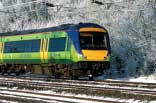Snow and trains are not a good combination. Rail users everywhere are used to shivering on platforms when the weather turns bad, waiting for the train to negotiate the slippery rails and frozen points. For railway engineers, coming up with new ways to keep trains running when the winter closes in is a complex problem — and it’s one where increasingly high-powered simulation software is now being brought to bear.
The problems that snow present go far beyond slippery rails. In regions with low temperatures and high snowfalls the loose, powdery snow blows around easily. A train passing over this will whip up a whirlwind of snow particles — and snow, of course, tends to stick to things.
For modern trains snow accretion is serious. Locomotives and carriages have many structures attached to their undersides, all of which can become encrusted with snow. This can have dire consequences for comfort and safety. Trains use many systems requiring air, particularly airconditioning and pneumatic braking, which run off compressors. The air intakes for these tend to be mounted underneath the train, and if they become blocked the results can be costly or even disastrous.

Markus Trenker and colleagues at Vienna-based Arsenal Research, the transport and energy arm of the Austrian Research Centres, have been studying this problem, and have devised a system to simulate snow accretion. Working with Siemens Transportation Systems, Trenker’s team has used computational fluid dynamics (CFD) packages to model the way that snow particles move around when the train passes over them, and how they stick to surfaces.
Modelling snow movement is a new area for train design, Trenker said. ‘As far as we know, nobody has tried this kind of simulation before.’ There has been a great deal of research about particles and how they move in airflows, he explained, but most of it relates to sand and soil; there has been relatively little work on snow, and what there is relates to accretion on static surfaces with more simple geometries, such as power cables, rather than on moving vehicles with complicated shapes.
The existing research was useful in some respects, Trenker said. ‘Snow particles behave broadly like sand particles — they move in similar ways in an airflow.’ In a light wind they undergo a process called surface creep — they lift up, travel a few centimetres and fall again. In a higher wind they travel further, but still follow a parabolic path; this is known as saltation, or jumping. And in a higher wind still, they enter the airstream and are blown for long distances; this is known as suspension.
But there are also important differences between sand and snow, Trenker said. ‘Snow particles can’t be regarded as hard spheres — they have a branched, dendritic shape, which gives them different aerodynamic characteristics. They change shape, they can be crushed and they can melt. The density and proportion of ice to water in the mix has an effect on their characteristics. Their properties change with temperature. And, of course, they stick to things.’
The behaviour of snow is, in fact, so complex that Trenker had to use a simplified version for his simulations. Aiming to mimic conditions in Oslo, he devised a set of data covering average particle size, density and surface area, creating what the team refer to as ‘default snow’, which they programmed into Fluent’s commercial CFD package.
For the behaviour of the particles they turned to a number of sources, including a study of soil transport on Mars, and made some assumptions on how the particles would behave — for example, particles hitting a surface at an angle of more than 45° will tend to stick, those that hit at a shallower angle will travel alongside the surface.

The simulations show clearly that the airflow underneath the train tends to concentrate snow particles — they have much longer residence times underneath the train than they do if they are caught in the airstream passing alongside. And the closer the under-train structures come to the track, the lower the air pressure between train and track, making it more likely that snow particles are sucked into the space. Compressor inlets tend to be low-slung structures, Trenker said; moreover, the mounting strut for the compressor inlet has a much higher influence on the airflow than expected, and is partly responsible for high accretion.
According to Trenker, Siemens intends to use the results of the simulation to redesign its trains so that air intakes are no longer located where snow can accrete. This, he believes, is a classic example of how simulation can reduce the cost of prototyping. ‘If you use this early in the design process you won’t have to start making costly changes when you’re actually building things,’ he said.
The system is versatile enough to be used for any type of flying particle, Trenker said, given accurate data on the particles’ aerodynamic properties. However, the team is concentrating on snow, and is now expanding its research to cover snow transport and build-up on different surfaces, such as roads and buildings. They are also refining their models. ‘We’re trying to change the shape of the surfaces as the snow builds up on them, depending on the accretion rate, so we get an accurate picture of the shapes the snow can form over time,’ said Trenker.
The work may also make the move from computer to actual simulation. ‘I really want to work with actual snow,’ said Trenker. ‘We want to use a snow machine and a wind-tunnel, and check how closely our results match the real situation.’




Poll: Should the UK’s railways be renationalised?
Rail passenger numbers declined from 1.27 million in 1946 to 735,000 in 1994 a fall of 42% over 49 years. In 2019 the last pre-Covid year the number...